31 Days, 31 Lists: 2023 Picture Books

And with that… we’re done.
For 31 days, my friends, I have worked tirelessly to provide a list a day of books published in 2023. The culmination, appropriately enough, is picture books. They are the most prolific titles published in a given year. They are also some of the best books you could hope to read . Today, I highlight my own personal favorites, knowing full well that there are books that I failed to see, and others that simply didn’t strike me in the right way at the right time. That’s okay. That’s why these aren’t “best” lists. These are just lists of the titles I think are truly great. If you missed some of them, be sure to check them out. They average out at about 32 pages, after all.
You can find a full PDF of today’s list here.
Curious to see what the previous years’ lists of picture books looked like? Behold the fruits of my past labors!
2023 Picture Books
Afterward, Everything Was Different by Rafael Yocktend, ill. Jairo Buitrago, translated by Elisa Amado
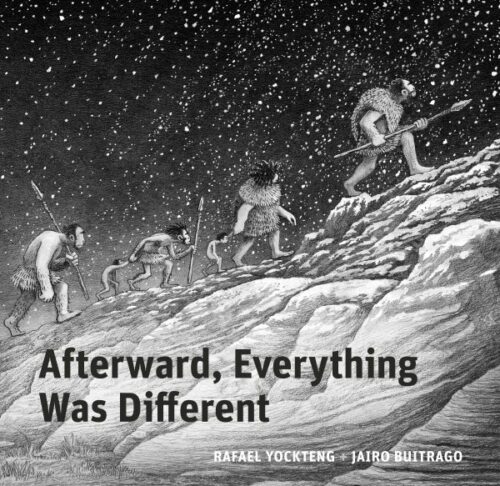
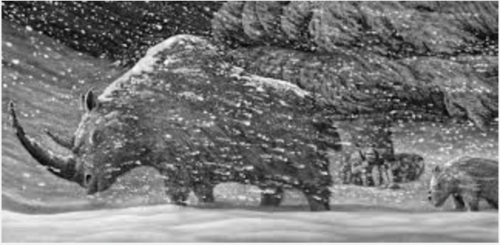
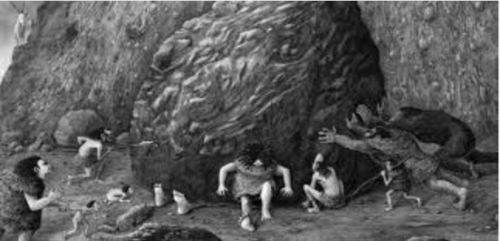
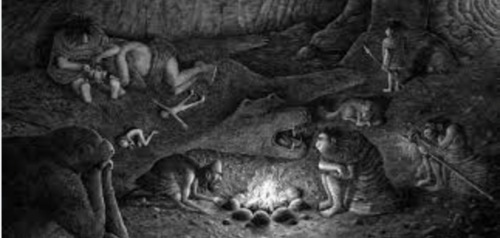
A group of early humans struggles to survive during the Pleistocene era. Meanwhile, a single girl watches and records everything that happens to them for posterity. An epic wordless tale about our earliest ancestors. I hereby declare 2023 The Year of the Wordless Picture Book. Between this and Aaron Becker’s The Tree and the River, we’re seeing massive time periods covered without a word on the page. Amazingly, this book highlights that impossible moment where humanity went from just trying to exist to trying to tell our stories to one another. It’s black and white, but you quickly forget about all that as you follow this group of humans (and their a human-adjacent friend, which I kind of love) tromping about during the Pleistocene era. I love the cinematic opening and it’s interesting watching their numbers deplete over time. I could read this again and again and notice something new with each read. Wholly, utterly engaging and original. Previously Seen On: The Wordless List
ADVERTISEMENT
ADVERTISEMENT
The Bear and the Wildcat by Kazumi Yumoto, ill. Komako Sakai, translated by Cathy Hirano
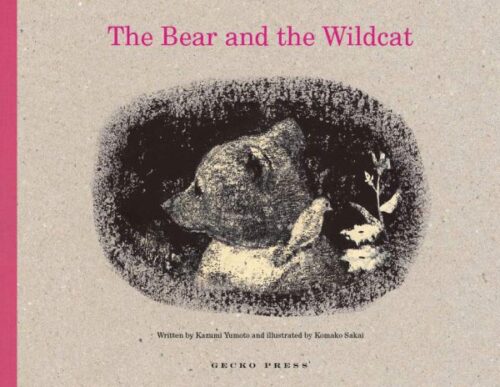
A little bird has died and Bear, the bird’s best friend, misses him dearly. When a new friend urges him to remember the bird, the story becomes a beautiful one of hope and healing, deftly told. Great writing (“His downy feathers were the colour of coral and his tiny black beak gleamed like onyx”) and the black images appear on the page as if they were scrubbed away from the surrounding brownish gray, like relief paintings released. It’s quiet and contemplative and rather lovely. I personally consider it this year’s Circles in the Sky. Previously Seen On: The Translation List
A Bed of Stars by Jessica Love
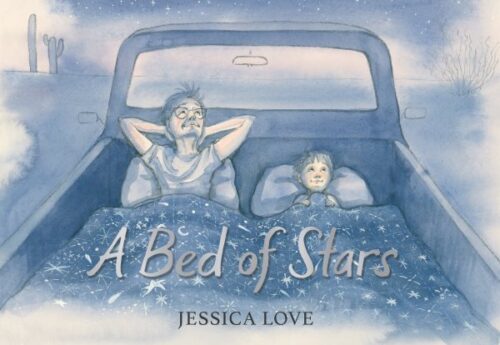
Scared of the dark and the night, a boy and his father set out for a camping trip. A gentle celebration of desert nature and how to feel less small in the universe. Bit of a change of pace for Love here. This book reads like a paean to the American South-West. It’s got pickup trucks and small towns on the one hand and camping and nature on the other. It’s kind of a nice companion piece to The Night Tent (visible later on today’s list), only in this case the parents recognize their child’s fear and do something about it. I like the tone of the piece and the gentle relationship to nature for everyday folks.
Beneath by Cori Doerrfelt
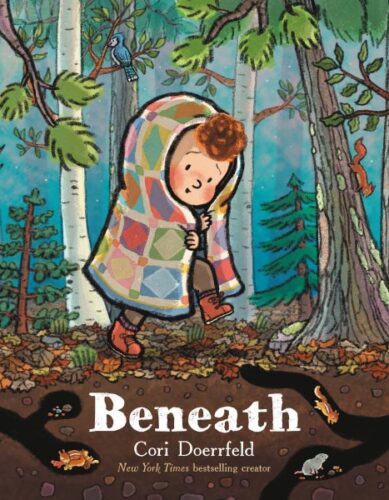
Finn is having an awful day. “Grandpa wanted to talk about it. Finn did not.” So Grandpa takes Finn on a walk and shows his grandson that things are very different just below the surface. Hooray! Doerrfelt finally lives up again to the promise of her last spectacular title The Rabbit Listened! It’s a simple idea (showing how things are different just below the surface) but done so gracefully and cleverly by Doerrfelt. Love the emotion of the piece and how beautifully she ties everything together with that clincher of an ending.
Big by Vashti Harrison
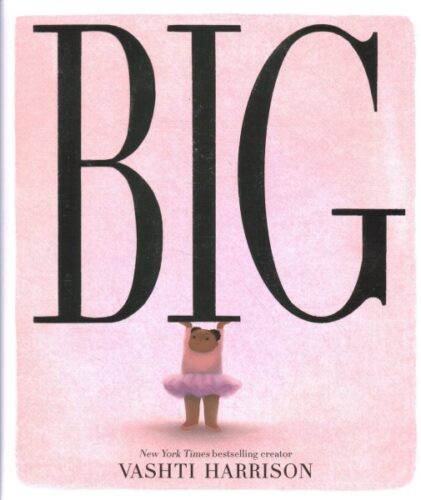
A little girl has a big laugh, a big heart, and big dreams. But when other people start tearing into her because she herself is big, she has to find the bravery to stand out. I can be a hard sell on books that I feel convey more of an overt “message” than anything else. Obviously a large percentage of such books aren’t really much good outside of the message itself. Harrison, however, just exudes talent. As far as I’m concerned the success of Lupita Nyong’o’s Sulwe was due in large part to Harrison’s art. Now she’s tackling fatphobia and particularly where it intersects with racism (though she’s less overt with the latter than the former). When she started working in some Alice in Wonderland references as well, I was truly and thoroughly hooked. And I’m not alone, since it was a National Book Award nominee as well. This book works and it works on beyond its own message. May it teach adults just as often as it does kids. Previously Seen On: The Unconventional List
Bing! Bang! Chugga! Beep! by Bill Martin Jr. and Michael Sampson, ill. Nathalie Beauvois
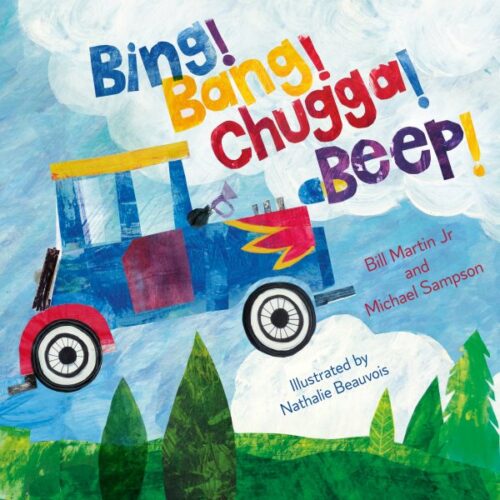
Sing along as a multi-colored car bings, bangs, chuggas and beeps down the road, in the clouds, and through the mud. Now I’m going to level with you. I think I was three pages in before I realized that the ideal way to go through this book is to sing it to the tune of “This Old Man”. The minute I started doing that, the old car just burst off of the page! Now correct me if I’m wrong here, but have we ever had a truly good picture book to this tune before? I’m 99% certain that we have not. If you are a storytime storyteller who enjoys singing, you are in luck. Could you read this without singing? I suspect that you could, actually, so for you non-singers, there is hope. As for seeing these images across a crowded room, Nathalie Beauvois’s art is a perfect accompaniment. An amazing storytime selection! Previously Seen On: The Readaloud List
The Brothers Zzli by Alex Cousseau, ill. Anne-Lise Boutin, translated by Vineet Lal
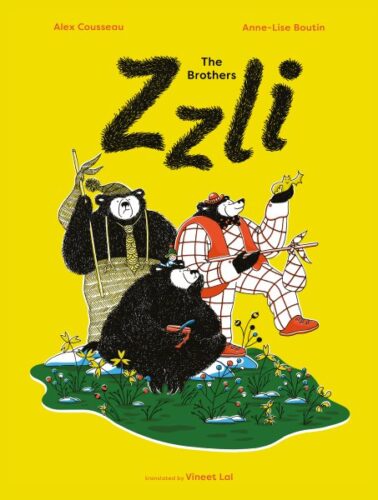
Let’s say that you are a writer of picture books and you are handed an assignment to write one about inclusion, immigration, and acceptance. Make it good. Make it furry. Just fill the darn thing up with bears. Now go. Of the requirements I just listed the most difficult one, without a doubt, is the “Make it good” part. Lord knows we’ve seen plenty of books on immigration or “accepting others” but boy can they get preachy real fast. To do the job properly you need to be a little weird. And Alex Cousseau is unafraid to bring the weird. The whole concept of this book is bizarre, but as extended metaphors go, I’m really quite fond of it. It’s told entirely in the first person (which is kind of rare right there) by a little girl who lives in a simply marvelous little green house deep in the forest. One day three bears arrive introducing themselves as “the four brothers Zzli”. Why four? “Maybe because we eat enough for four.” In spite of their prodigious appetites she finds them “truly delightful.” Driven out of their home they’ve gone through a lot of hardship in their travels and just want to settle down somewhere safe. She invites them to stay with her and all is well for a time. Unfortunately it soon becomes clear that the other animals in the forest do not trust these bears a jot and when that fear turns into pretty much firebombing the girl’s cottage, the bears decide to leave. She goes with them (I mean who would want to live in that community?) with the hope that someday they’ll find a spot where they can all belong. There’s a wordless four-page spread at the end that suggests that they succeed. One can hope, that’s for sure. Done entirely in primary colors, it’s just the loveliest story, but doesn’t skimp on showing how fear makes people do terrible terrible things. Man. You gotta read this one. Previously Seen On: The Message List
Catside Up, Catside Down: A Book of Prepositions by Anna Hrachovec
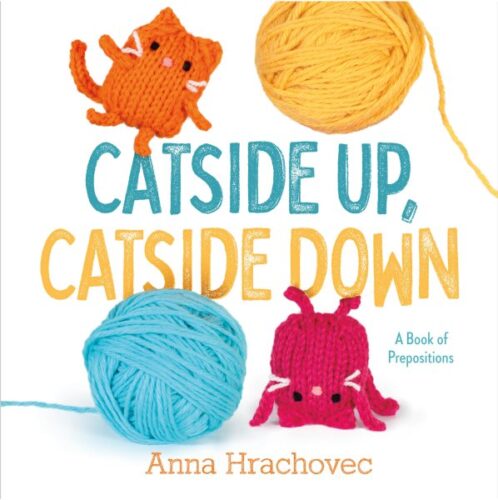
Cozy kitties in kooky situations are up, down, on, and around. Simple and hilarious, these gentle rhymes are a sure-fire hit. I am on board with this book because it is weird. It is a weird book about prepositions. And strange and that may sound, that’s in my wheelhouse. I mean, about the point where I realized that someone in this world (that someone being Chicago resident, and therefore neighbor, Anna Hrachovec) had taken literal minutes of her wild and precious life and used them to knit a tiny toilet with a cat in it (accompanied by a tiny knitted plunger) I threw in the towel. How am I supposed to resist this? It’s a simple book for kids (which we always need) and the prepositions aren’t just the usual suspects. Love the words “configure”, “astride”, and “astraddle”, to name but a few. Gotta give it up for the wackadoodle knitted kitty book. Previously Seen On: The Simple List
The Concrete Garden by Bob Graham
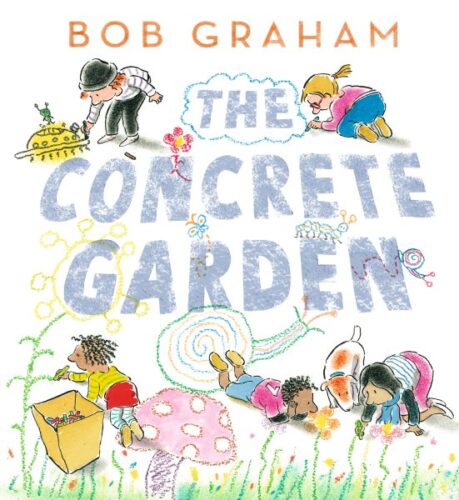
Doggone it. How does Bob Graham do it? The idea that he was working on this book during the early days of COVID while all the rest of us were vegging out watching Tiger King is almost unbearable. Yet the fact of the matter is that when it comes to early pandemic picture book tales, this may be the best we’ve seen so far. Why? Subtlety, my friend. In this story Amanda and her mother live in this massive apartment block. It’s early spring (Spring 2022, I’d wager) and the kids pour out of the building like “candies from a box”. Amanda has been lugging a large cardboard box full of chalk, and she proceeds to create what appears to be a very large image of a COVID-19 virus. Without missing a beat, one of her friends turns it into a dandelion and suddenly all the kids are getting involved (with surprisingly little strife in the process). The image of their “concrete garden” goes viral, but that affects them not at all. And when everything washes away a few days later, are they sad? No! They’re making little cardboard boats and racing them in the water. There are probably ten different messages that you could choose to take from this book. However you want to look at it, it’s certainly about kids being kids and that’s what may save us all. Previously Seen On: The Message List
Desert Jungle by Jeannie Baker
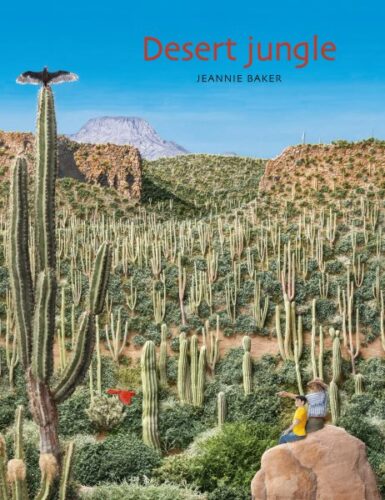
When a boy goes to visit his Grandpa in the desert, he’s initially terrified of the wilderness. Breathtaking collage highlights the boy’s discovery of nature in all its myriad forms. Australian artist Jeannie Baker has a style that literally no one else in the world can replicate. I’m fairly certain that it’s been something along the lines of seven years since the last time she released a fictional picture book. A great deal of her strength lies in creating the illusion of depth and distance. Now she’s turned her eyes upon the valley of the Sonoran Desert and the results are as jaw-dropping as you might imagine. Both this book and A Bed of Stars (previously mentioned) consider desert ecological systems. This one adds in the extra added layer of learning from your elders as well. Nature at its finest.
Dim Sun Palace by X. Fang
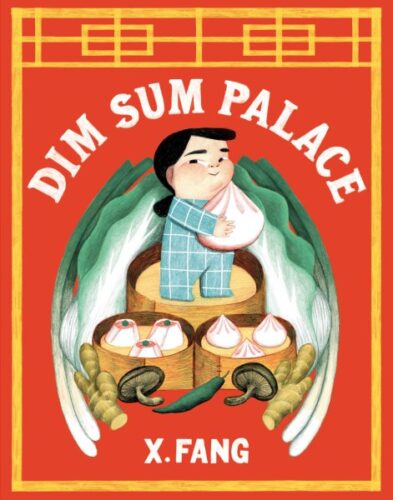
Oh ho! This little book almost escaped my notice this year, but fortunately I caught it at the last minute. Essentially what we have here is a kind of magnificent update to In the Night Kitchen (with the notable difference being that in this book our heroine gets to keep her clothes on the whole time). When told that she’ll be going to the “Dim Sum Palace” the next day, Liddy is so freakin’ excited! A palace! How cool is that? And, if you’re a parent reading this book, you’re girding yourself for her inevitable disappointment. What happens instead, though, is that she has an amazing dream about being a tiny girl going to an actual palace with an Empress and everything. There are wacky hijinks involving falling into a bowl of dumpling filling and almost getting devoured like a Lilliputian by the titular empress. Fortunately, Liddy is saved and gets to eat dumplings that are as big as she is. After she wakes, she discovers that she isn’t going to an actual palace to eat, but you know what? “…Liddy didn’t mind one bit, because the food tasted better than in her wildest dreams.” This is apparently X. Fang’s debut picture book and like Liddy and her food I want MORE! More books! She has this distinctive and incredible style, to say nothing of how impressively simple she’s been able to keep the text. Best of all? Those endpapers. They’re green and spotted with different kinds of food, from spring rolls and ma lai go to roll cakes and chicken feet. Don’t read while hungry, that’s all I ask.
Do You Remember? by Sydney Smith
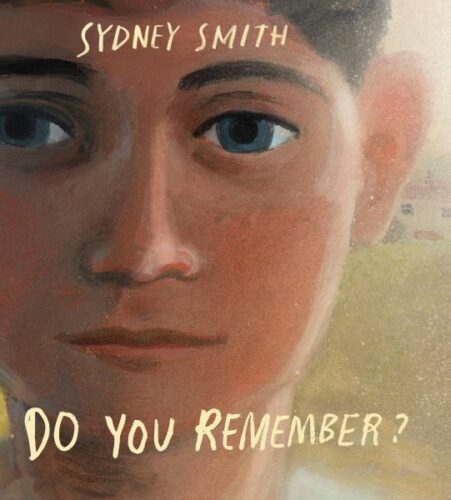
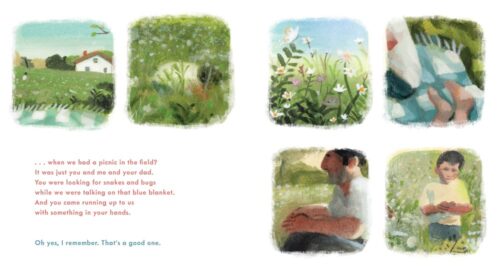
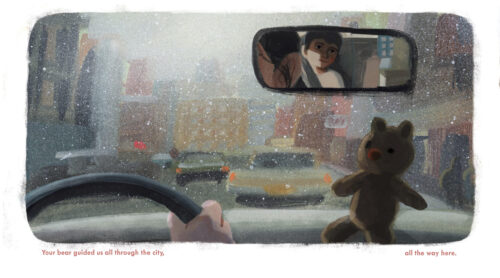
“Can we make this a memory too?” A boy and his mother lie in bed remembering happy and sad times from the past in this sweet and evocative tale. Doggone it, who gave Sydney Smith permission to put two books out in the same year? Not cool, Sydney. Now I’ve have to deal with a load of trouble on my hands figuring out which one to include on one list or another this month. I’ll confess that personally I still think that his other title My Baba’s Garden is my personal favorite (based entirely off of what he’s doing with light in that book) but we can’t discount this one at all. At first I thought it might be about a son and mom remembering a deceased father but it appears to be a lot more open than that. You could interpret this in a lot of different ways (which sort of reminds me of that picture book Boats for Papa, actually). Fabulous tone, writing, art, and design. This is the first instance you’ll see today of a Canadian artist who cannot win a Caldecott, but not the last. Previously Seen On: The Caldenott List
Eclipse by Andy Rash
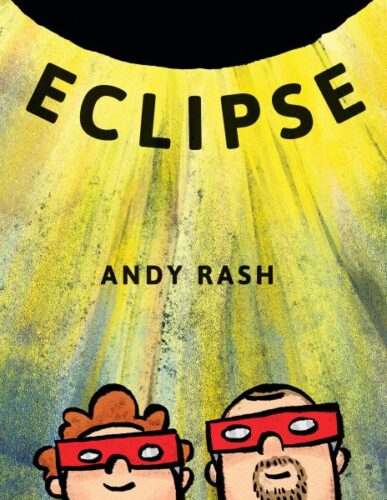
In two months there will be a total solar eclipse and a boy and his father are determined to see it for themselves. Take a trip to experience one of the coolest natural phenomenon you might ever be lucky enough to witness. Every year I stumble on at least one book that I would have fought to have on my library’s 101 list, but it’s just a touch too late. This year, this is the book. I wish I’d gotten my hands on it even a week sooner. Andy Rash does this incredible autobiographical tale of traveling with his son to see a total eclipse for the first time. I love Rash’s style anyway, and this book does a superior job of making you excited to see an eclipse for yourself. Best of all? Rash includes endpapers that show all the upcoming eclipses (and how bizarre to see the year 2048 in a picture book, eh?)
Evergreen by Matthew Cordell
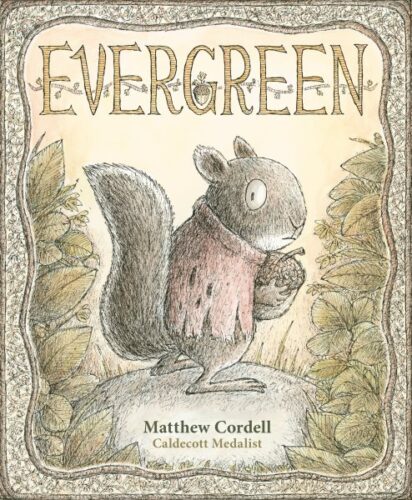
Little squirrel Evergreen has many fears, and must face each one individually as she heads into the woods to deliver healing soup to ailing Granny Oak. I usually try to eschew the “instant classic” status, but once in a great while it’s deserved. The thing I like about Cordell is that he’s unpredictable. Recognizable, but always trying new things. It’s funny that considering the limited color palette here, I wouldn’t change a thing about it. I love Evergreen (who can’t relate to her anxiety?) and how this book mistakenly makes you think that it’s going to be a Little Red Riding Hood pastiche. When it wins the Caldecott I hope the banquet serves copious bowls of soup in celebration.
Every Dreaming Creature by Brendan Wenzel
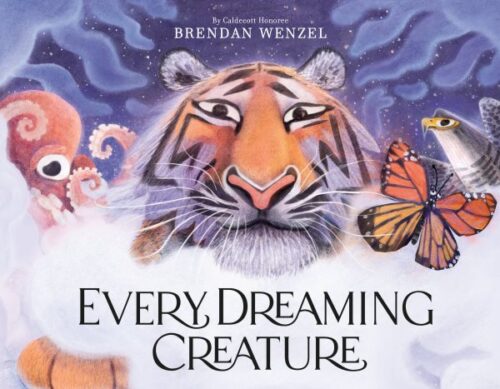
“I had a dream I was a sleeping salamander.” Join this bedtime book as it slips effortlessly from creature to creature, illuminated by the sumptuous art of a Caldecott Honoree. Wenzel is pretty consistently good and this book is no exception. It’s an excellent example of how you can work the natural world into your books seamlessly. This has a drowsier feel than his other titles, which means it’s probably a bedtime book more than anything else. Sleepy STEM for young readers then.
Firefighters to the Rescue! by R.W. Alley
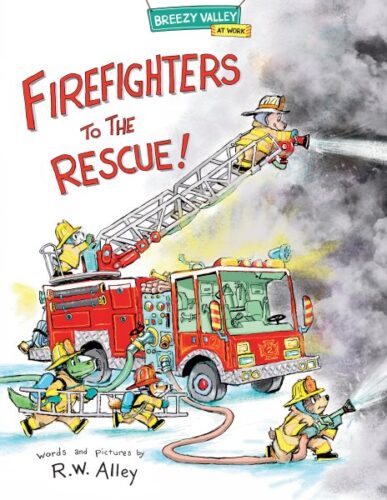
Is it just me or has David Macaulay been blurbing a LOT more books this year? Maybe he retired and finally has time to read through all the titles that folks have been passing along to him. This is just the latest title to be graced with his blessing (he called it, “Full of life and humor and real information. I had a smile on my face from the very beginning. It only disappeared a couple of times… when I was laughing.”) Not too shabby. R.W. Alley may be best known these days as the current illustrator of the Paddington books, but his talents are numerous. Case in point, what appears to be a new series called “Breezy Valley at Work”. This first entry takes place in Breezy Valley (you get views of the extended town on both the front and endpapers, of course). The book then goes through the day in the lives of some of its firefighters. In the Acknowledgments at the start, Alley is quick to note, “Even though the firefighters of the Breezy Valley Fire Department may not look like those of your local fire department, great care has been taken to make certain that their methods and equipment reflect firefighting procedures in the human world.” And it shows! As someone who once read countless firefighter picture books to her own son back in the day (I still have a Top Five list in my head, to which I am adding this book as a potential #1) it was kind of a relief to see a book that didn’t have the firepole/dalmation tropes. Alley has the miraculous ability to make a book both highly detailed and cozy all at the same time. There are storylines to follow here and even different kinds of fires and the different ways to fight them. Does Alley owe a debt to Richard Scarry? Maybe, but if you want something Scarry-esque but up-to-date and very cool in its own right, I can think of no finer book. I don’t tend to put firefighting titles on my best of the best lists, but this title? Completely deserving.
Grandma’s Tipi: A Present-Day Lakota Story by S.D. Nelson
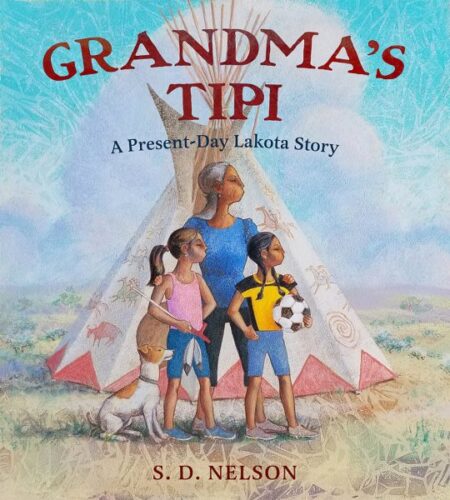
When Clara and her cousin Juniper spend their summer with their Grandmother, they learn all about their family and tribal history, all tied to the family tipi passed down through the generations. S.D. Nelson (Standing Rock Sioux Tribe) has been making children’s books for years and years and years. This may be his most sophisticated title to date too. He brings his acrylic paints on gessoed MDF boards and just creates these awesome, spectacular images throughout. I thought this book did an excellent job of showing contemporary kids connecting to their past (and I love that they were painted as playing basketball and flying jets on the walls of the tipi). Is it one of the best of the year? No question. Take a read and you’ll see why for yourself.
Grandpa and the Kingfisher by Anna Wilson, ill. Sarah Massini
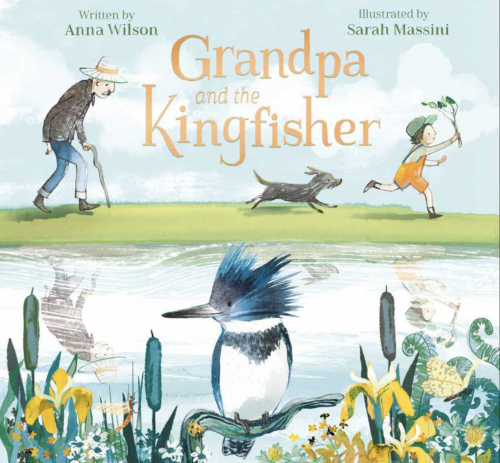
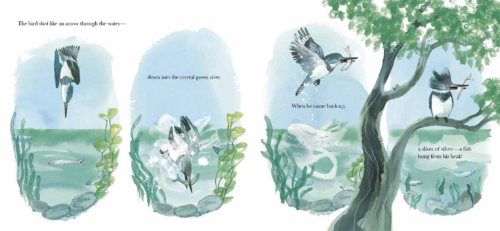
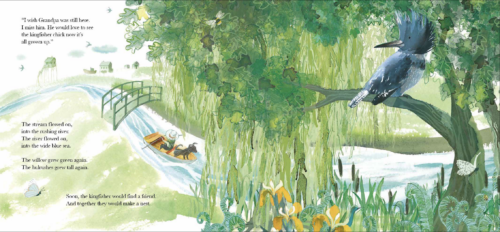
As a grandpa and his grandchild observe a kingfisher and its life, a story is imparted about nature, the seasons, and our place in the world. “Nature goes on like this. Nature goes on forever.” You know when you’re reading through a pile of picture books in the vain hope that you’ll be able to write off some of them and then, horribly, you just keep on finding gem after gem after gem instead? This book already had a bunch of marks against it. 1. It’s a grandpa book and I think we’ve seen approximately 523 of these so far this year. 2. It’s a death book and those are usually really squelchy in terms of the emotions. One point in its favor was that it was a nature book as well, but since we just saw a kingfisher book win a Caldecott Honor recently (Mel Fell), I kind of felt like that box was checked. This is all to say that I was wrongedy wrong wrong wrong about all of this. Doggone Anna Wilson is excellent at what she does and this book is deeply touching without ever being treacly. Moreover, Sarah Massini was the perfect illustrator to accompany her. This may be my favorite death book I’ve seen in years. I’m in awe.
Hanukkah Upside Down by Elissa Brent Weissman, ill. Omer Hoffmann
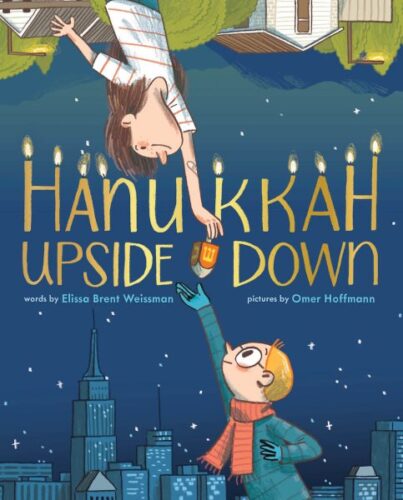
With apologies to all the other Hanukkah books out this year, behold my absolute favorite!! It is rare for me to put a holiday book on both my Holidays list and my Best Picture Books list of the year, but that’s just how good this little book by Weissman and Hoffmann is. My sole regret is that I encountered it as late in the year as I did. In this story you have cousins Nora, living in New Zealand, and Noah, living in New York. They talk on the phone all the time but they also find one another’s Hanukkah experiences to be utterly backwards. To settle things once and for all, they have a competition: Who can have the world’s best Hanukkah? Weissman then proceeds to do this clever little pairing of each activity that Nora or Noah does that’s different on each of the eight days, but in the end they both always end up doing the same thing. Example: “Noah threw snowballs. Nora did cannonballs. But on the fourth night of Hanukkah, they both gave tzedakah to help repair the world.” The end result is that you learn a lot about each night of Hanukkah, but not in a way that feels teachy. Omer Hoffmann, meanwhile, is utilizing this kind of Quentin Blake/Matthew Cordell-esque style that perfectly captures all the fun that each kid is having on a given day. Love the mirroring of each character, and I also love that we live in an era where these kids are talking to one another on the phone and posting their experiences into a shared online album, rather than relying on something archaic like handmade letters. The whole book feels fresh and fun and utterly original. Previously Seen On: The Holiday List
Homeland: My Father Dreams of Palestine by Hannah Moushabeck, ill. Reem Madooh
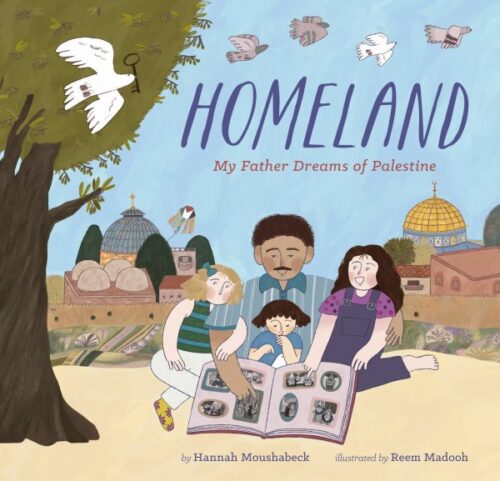
I’m giving Moushabeck and Madooh some extra points for (A) managing to get a picture book about Palestine on our shelves from a major publisher in the first place and (B) finding a way to tell this tale in a contemporary, accessible, interesting way. There were a lot of different choices that had to go into this telling. Do you include any history in the backmatter? If so, how much? A timeline? For Hannah, this is from the p.o.v. of someone raised in one country but hearing from all their relatives about another. In her Author’s Note she writes about the stories she and her sisters would hear from their mother, father, aunts and uncles. The book is set up in very much the same way, and gives about as much context as a child might receive. It’s only when you get to the backmatter that you learn a little bit about Al-Nakba on May 15, 1948. It’s a loving story told in a wholly original way. Timely to say the least.
How Does Santa Go Down the Chimney? by Mac Barnett, ill. Jon Klassen
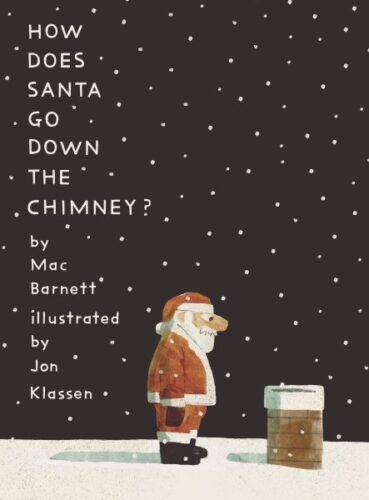
First and foremost, Jon Klassen dedicates this book “To Santa” which is the best use of a holiday book dedication I’ve seen to date, and I think it deserves some praise. But let’s just get down to the nitty gritty. When picture book creators hit a certain level, a lot of them will try their hand at a holiday picture book. Heck, just this year we’re seeing Don’t Let the Pigeon Drive the Sleigh (it goes pretty much the way you’d expect it to). Even the great Dan Santat illustrated a Christmassy picture book (and if you’re asking if I’m shamelessly pandering, I am and I have zero regrets). But when Mac Barnett and Jon Klassen make a Santa book together, it doesn’t feel like they’re hooking their train car up to a larger trend. Instead, it feels like a personal challenge. Just last year the two of them tried their hand at recreating a classic fairytale (The Three Billy Goats Gruff, if you’re curious). Now they tackle the big man in red, but in their own inimitable style. Mac looks at the problem and comes up with an essential question that many children ask. Mainly, how the heck does Santa get down that chimney? And what if you don’t even have a chimney? What then? Respecting the intelligence of his readers from page one onward, Barnett tackles each problem and possibility, approaching his subject matter the same way a scientist might. This works because his art is coming to us via Jon Klassen, a man capable of presenting a reindeer holding a cup of coffee better than any reindeer has ever held a cup of coffee before. His Santa isn’t befuddled. More, he’s a man approaching life’s challenges as they are presented to him. There’s a moment when Santa looks down at a plate, not of cookies, but of carrots that feels more poignant than any of the previous escapades involving chimneys or doggies or night vision goggles. This is, and I mean this sincerely, my favorite Christmas book of the year. I think it balances neatly between amusing kids and amusing adults equally in turns. In other words, the Barnett/Klassen sweet spot. Previously Seen On: The Holiday List
Hurry Kate, or You’ll Be Late! by Janice N. Harrington, ill. Tiffany Rose
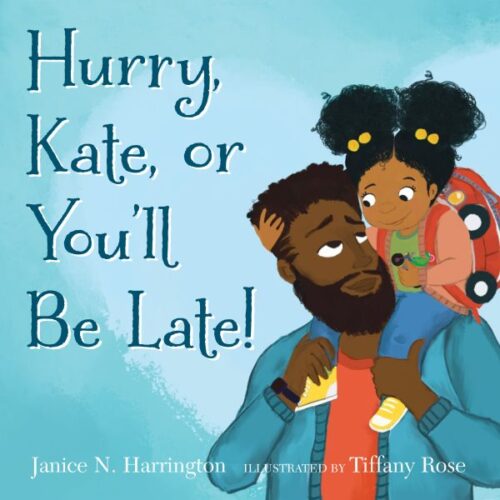
When I was first starting out as a children’s librarian there was this picture book I liked to use on racist white parents. They’d ask me for picture book recommendations and when I pulled out ones with Black kids on the covers they’d scrunch up their noses and say, “Oh.. um. I was looking for something a little less… urban?” I’ve found that the best response to racism in such situations to take a person at their word so I’d immediately grab the marvelous The Chicken-Chasing Queen of Lamar County with its beautiful Black girl on the cover and its distinctly RURAL setting and hand it to them with a flourish. This was back when finding any Black kids on picture book covers was a difficult thing to accomplish, so I’ve always had a great deal of gratitude held for Janice N. Harrington. What I love is that a good 16 years after that book was released, Ms. Harrington is still blowing and going and producing all kinds of gorgeous books along the way. This one’s loads of fun since it has this very clever set-up right from the start. The very first thing you learn is that “Kate was late for preschool.” The book then proceeds to negate every possible reason she could have been late. “Not because she asked her daddy for cold slushy chocolate milk / Not because he brushed her hair into big fluffy puffs.” Everything is in the negative but tells you about her day, which is an exceedingly clever technique for innovating storytelling. You even get a fair amount of character development in there too, like the fact that Kate is clearly into vehicles and construction equipment. Artist Tiffany Rose also adds little details that I appreciated, like the stoplight in Kate’s room (which, let’s admit it, many a parent has tried to use for early waking children). This is a true original that I’ve little doubt you may have missed this year.
If I Was a Horse by Sophie Blackall
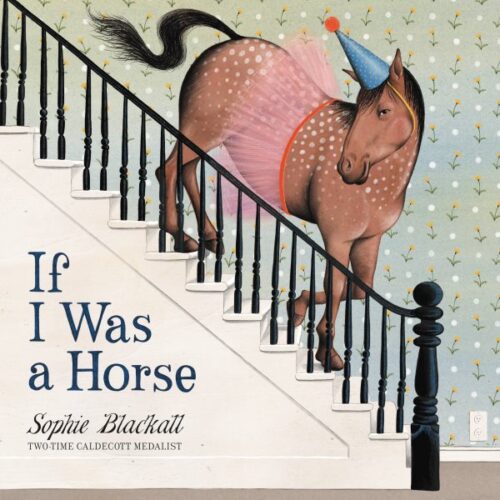
What would you do if you were a horse? Would you run all day? Refuse to wear clothes or take a bath? Give your little sister a ride? A fun frolic with a clever equine. Feels like a bit of a flex. I’ve heard that the most difficult things to illustrate tends to be horses and bicycles. This book sort of feels like Blackall considered that fact then responded, “Challenge accepted!” Because as it turns out, she does a darned good horse. It’s an interesting example of a picture book with a very classic conceit (a kid imagines all the stuff they’d get up to if they were a horse) but with a LOT going on under the surface. You actually have to read this quite a number of times to figure out precisely everything that’s going on. There’s the surface story and then a lot more besides. Though she never comes out and says it, there are hints in this story that the main character may be LGBTQIA+ in some way (the brother knitting the rainbow scarf which he waves like a flag during an indoor parade, the gender neutral bedroom, and other clues come to mind). Twenty points to anyone who can identify the comic that the brother is reading. Well worth all your consideration.
Jump In! by Shadra Strickland
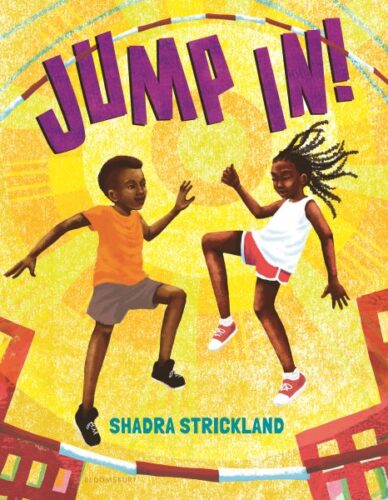
“Ticktack, ticktack through the wind. / Feet bounce up the block in time … Jump in!” Join a hot summer day on the asphalt as kids (and adults!) show the different ways to jump in and have a good time in this vibrant paean to fun. There’s this little mention at the front of the book by the author where she says that the art in this book has been influenced by the work of Italian Futurists. I wonder now if I would have picked up on that at all if I hadn’t read it first. What I definitely would have noticed was how much joy and sheer energy there is in these pages. This actually feels like a contemporary update to last year’s The World Belonged to Us by Jacqueline Woodson. Only here, you not only have kids “jumping in” (and that can mean a lot of different things) but adult community members that all the kids are familiar with too. About the point that the reverend was jumping in, I was sold on the book. Skip to it and give it a read.
Just One Flake by Travis Jonker
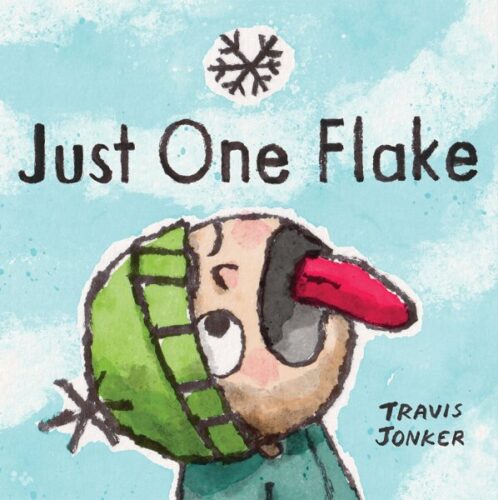
Let’s wrack our brains a little. I know you can help me with this. If you would be so good, please remind me of all the children’s librarians in the world who didn’t just transition to writing picture books for children, but also went so far as to illustrate those books themselves to boot. I’m thinking of multi-Caldecott winner Marcia Brown, of course, but anyone else? How about Travis Jonker? Here’s a fellow who for years was sending his friends tiny illustrated pamphlet picture books in the mail (much as Mo Willems used to do at the beginning of his career). He’d done some lovely picture books with illustrators (be sure to check out his future title with Caldecott Award winner Matthew Cordell!!), but now he’s created a picture book of his own WITH his own illustrations and it’s his best yet. The story is that universal desire to catch a snowflake on your tongue. Trouble is (and I think we can all attest to this) it’s not as easy as it looks. Like Charlie Brown trying to kick that football, our hero is repeatedly thwarted in his attempts until the denouement at the end. Jonker finishes strong with the silent gag on the last page, and then, of course, there’s the case of the book. If you remove the cover you’ll see an array of pretty snowflakes created by everyone from Cece Bell to Minh Lê. Full disclosure: I’m in there too. The book reads aloud brilliantly and best of all has a simple text that the younger kids will get behind. A winner! Previously Seen On: The Simple List
Just Like Grandma by Kim Rogers, ill. Julie Flett
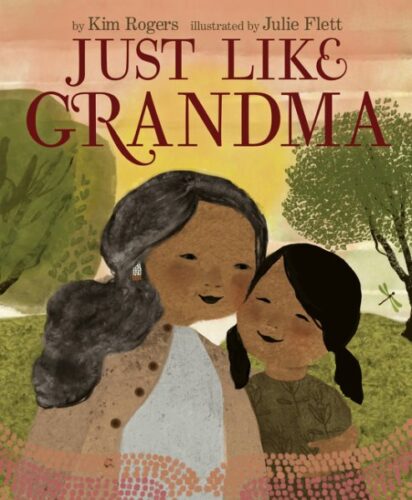
Becca wishes she could bead, dance and create art just like Grandma. But she learns that she too has things she can teach her beloved Elder. Okay, yeah. I completely see what Brian’s getting at here. And he’s right, this is hardly the first grandparent/grandchild picture books we’ve seen in the last few years. I think what lifts this above the crowd, though, is the simple fact that the writing on the part of Rogers here is so good. What could have been rote and treacly is elevated by the fact that you get those repeated lines of Becca wanting to be like Grandma, and then that surprise emotional switcheroo of Grandma wanted to be like her. Both throughlines come together with that great “just like” capper at the end. And special shout out to Grandpa for making all that delicious sounding food as well.
Like Lava In My Veins by Derrick Barnes, ill. Shawn Martinbrough with Adriano Lucas
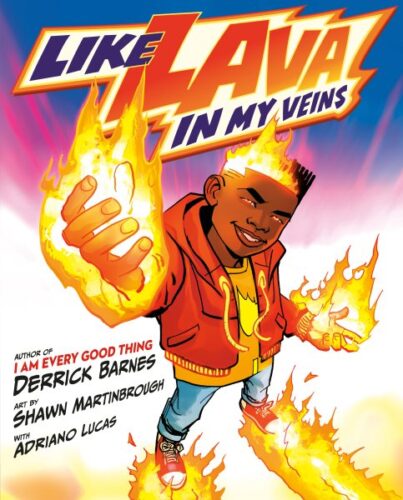
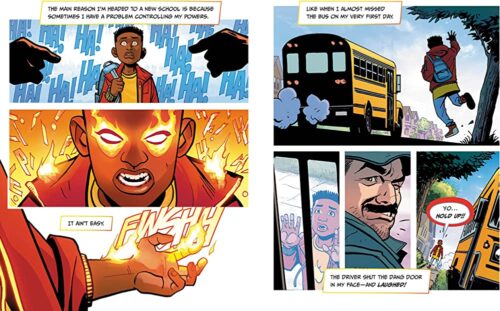
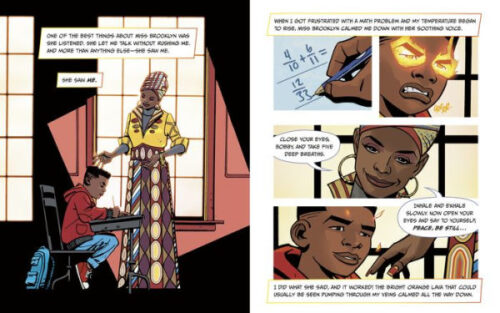
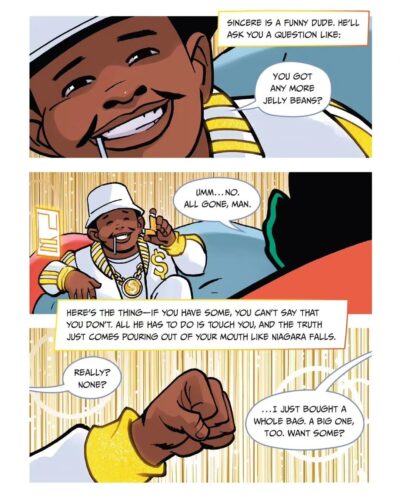
Bobby Beacon is as superpowered as the other kids at Akwaa Academy but that doesn’t mean things are easy for him. A smart comic book-styled story about who we give second chances to, and who we don’t. It’s funny to say, but picture books that have been drawn to resemble comic books have been around for a really long time. And they are almost always, without exception, unimpressive. Why? The art might be fun but the text is always meh. But if you get an author like Derrick Barnes to take a stab at the material then things start perking up significantly. The whole reason this works is that both the story being told, and the underlying story beneath, work. Besides, I wouldn’t mind seeing an entire series based around the character of Sincere. This charmed and surprised me, which is always a good thing.
Mama Shamsi at the Bazaar by Mojdeh Hassani and Samira Iravani, ill. Maya Fidawi
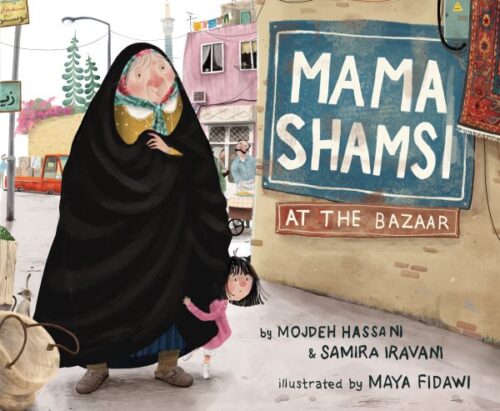
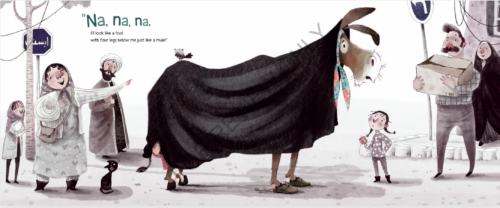
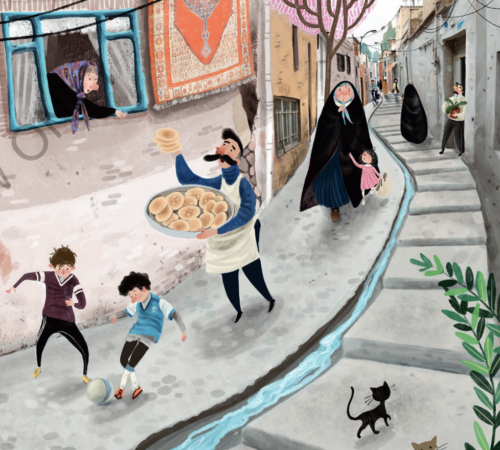
Set in Iran, this story follows little Samira as she gets to go to the bazaar with her grandmother for the very first time. Now this tale could just be one of those books where the setting is the plot. Lots of those exist and they are, quite frankly, not always very meaningful. This book, on the other hand, does this brilliant job of making you understand just how fun it is for a little kid to play under their grandmother’s big chador. Read the authors’ notes at the back and you realize that for kids with chador-clad grandmothers, this is a kind of universal way to play. In this tale, Samira gets increasingly nervous as she approaches, so she keeps bugging Mama Shamsi to let her climb on her back or let her be behind, etc. Each time her grandma says no, pointing out what kind of animal they’d resemble if her granddaughter was under there. These authors actually managed to make the book rhyme rather well, giving the story a fun sing-song quality (ideal for storytimes, y’know). But one of the other huge lures is the art of Maya Fidawi who fills these pages with details like a zanbil, a Shahr-e-Farang, a joob, open canals that line the roads, and more. Set unofficially at the Tajrish Bazaar at the end, it would make a really cool companion to the Raúl The Third’s book ¡Vamos! Let’s Go to the Market. Previously Seen On: The Readaloud List
Mr. S by Monica Arnaldo
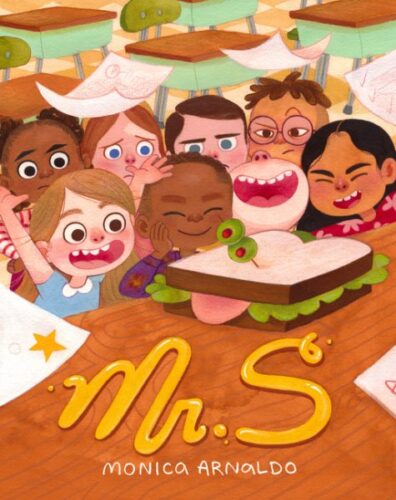
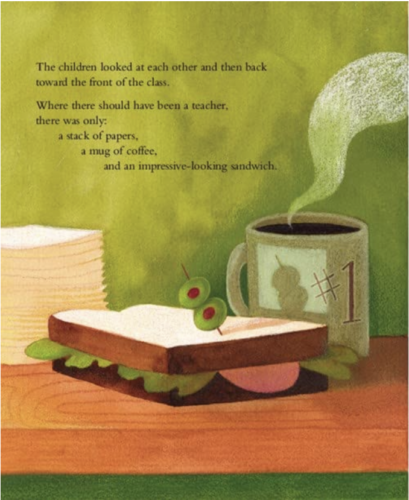
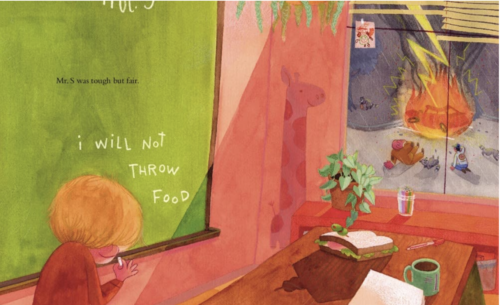
When a classroom full of new Kindergartners come in on the first day of school they don’t find any adults, just a sandwich on a desk. Could this be their teacher?!? Initially when I heard the premise of this book I thought it was just a logical extension of that moment on The Good Place where the main characters can’t figure out if a supernatural judge is a burrito on a desk or not. This lifts that premise and places it on the first day of school where a classroom of kindergartners come to the logical conclusion that the sandwich on a desk is definitely in charge. Personally I also loved the background story of what’s happening to Mr. Spencer (the man seen writing on the blackboard at the start) all the while. Good twist, great art, and you’ll see why Adam Rex’s blurb on the back says, “This might be the funniest first-day-of-school book I’ve ever read.” The man’s not wrong. Previously Seen On: The Funny List
My Baba’s Garden by Jordan Scott, ill. Sydney Smith
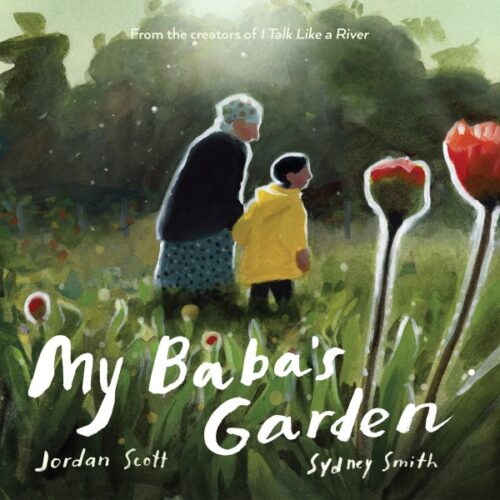
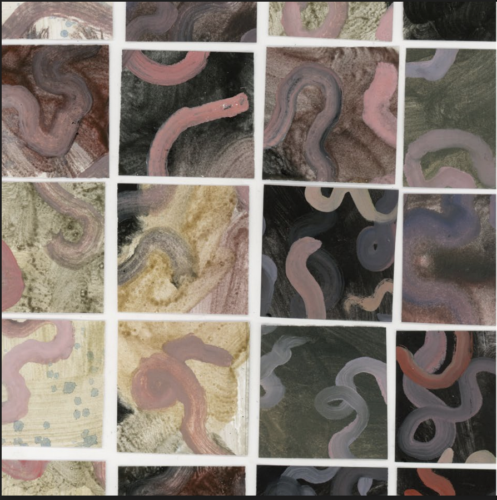
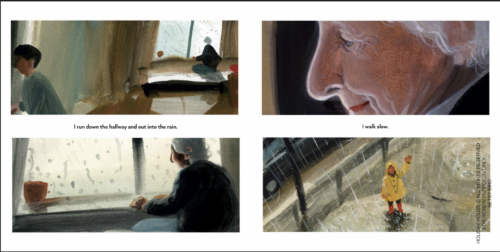
Every morning, before school, a boy is driven to his grandmother’s tiny house where they take walks and save worms on rainy days. An evocative look at childhood and the small kindnesses we can do for the ones we love. The team that brought you I Talk Like a River is back with a very different story from Jordan Scott’s youth. Scott is rapidly specializing in a genre that I could only describe as Picture Book Memoir (which is a longstanding tradition, but he elevates the form). It’s not a terribly dramatic story, but it grounds you in such a sense of place. Plus, as an adult you’ll have the extra added advantage of seeing things both from the grandson’s point of view and as an adult, seeing why the grandmother does the things that she does. Of course a good chunk of the reason to read this book is simply to watch what Sydney Smith does with light. That cover alone is almost (almost) enough to make me try my hand at growing poppies again. One of the most heartfelt titles of the year.
My Strange Shrinking Parents by Zeno Sworder
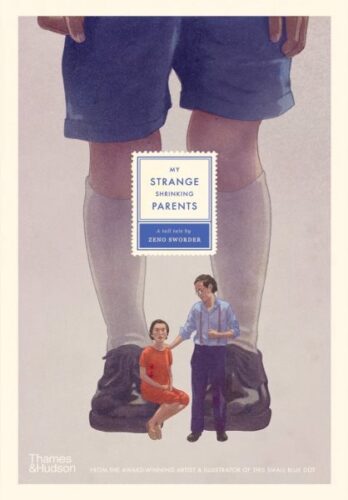
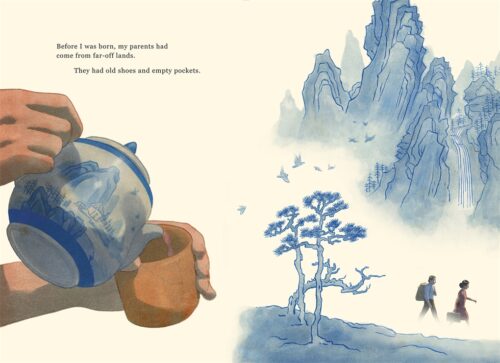
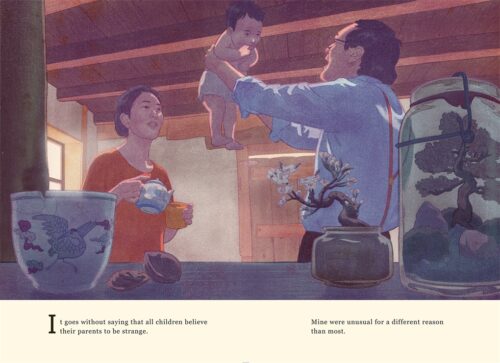
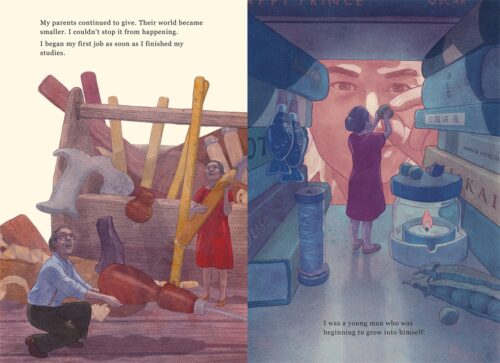
The narrator of this tale tells a peculiar and beautiful story of how his immigrant parents traded inches of their height to support their son. As he grows up, they grow down. A story of love and of sacrifice. And Australian! Ever noticed how good they are these days at original immigrant narratives? With immigrant parents, Zeno’s story is a metaphor about the sacrifices people make for their children. In his dedication, the author says he was inspired by Japanese woodblock prints by Hokusai and Hiroshige and books by Oscar Wilde, Shel Silverstein, and Stan Sakai. And weirdly enough, I feel all those influences here. It’s not just that the written words or the bizarre story, but also the sheer beauty of the art itself. The publication page doesn’t reveal how the art was made but it’s so strangely beautiful. Realistic enough so that the strangeness seeps in but never distracts. There are even gorgeous wordless two-page spreads that give the reader time to think and to talk. I can’t think of a book exactly like this one. It’s a complete original and beautiful to its core. Previously Seen On: The Unconventional List
Nell Plants a Tree by Anne Wynter, ill. Daniel Miyares
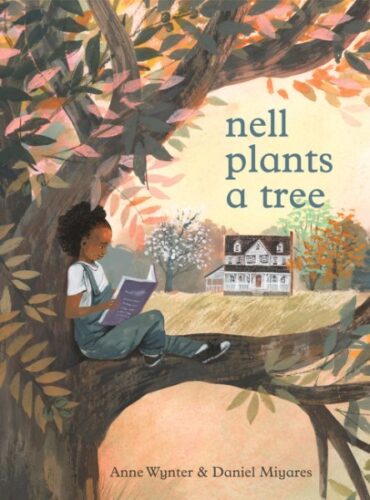
Alternating between the past and the present, two young girls play outdoors. A tale rooted in family, history, and how you need to care for something to help it to grow. Huh! Well this just feels like a natural companion to The Red Box (mentioned later on this list), now doesn’t it? There’s a sophistication to this storytelling that we don’t always see in picture books. For that reason, I can see why Miyares chose to keep some of the characters in virtually the same clothes throughout their lives. Without being overt or obvious about it, this book does a remarkable job about talking about roots, both literal and figurative. It’s almost like a puzzle too, making young readers suss out what exactly is happening. On the surface this looks simple, but underneath there is a lot going on.
The Night Tent by Landis Blair
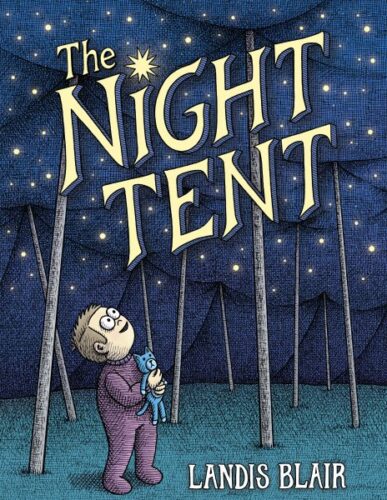
At night Watson’s anxieties keep him wide awake. That is, until he discovers an entire world under his covers (and maybe the key to real shuteye). So if the name “Landis Blair” is ringing loud in some far and distant part of your cerebral cortex, you may be familiar with his VERY adult (and VERY good) The Hunting Party, which came out a few years ago. This switcheroo to picture books feels like nothing so much as evidence of his incredibly healthy mind. Anyone capable of that book and this one must be quite balanced in heart and soul. If you know me then you know that I love books that take an idea to its logical extreme. So this doesn’t just create a world under Watson’s covers. It creates an epic journey to boot. I love how with every protestation that he’s not sleepy, his eyes belie the statement. Cozy kookiness. Sleep never looked so good.
Obioma Plays Football by Chika Unigwe, ill. Chinyere Okoroafor
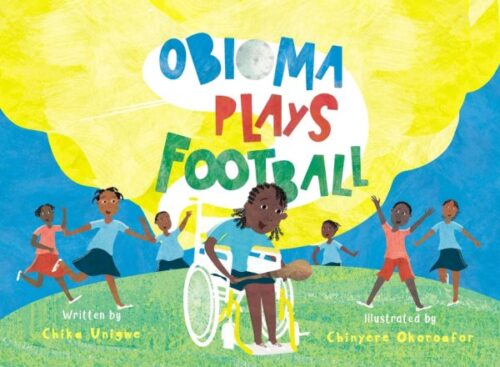
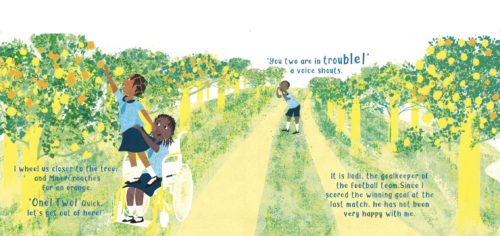
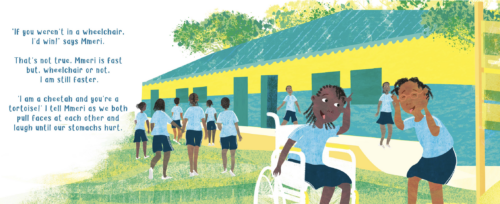
I feel a little bad putting this particular book on this particular list, because I actually think it’s a wonderful example of a book simply being good on its own merits, and devil take the whole “message” idea. Author Chika Unigwe doesn’t ignore the fact that Obioma is in a wheelchair, and indeed the plot centers on her move from a school that’s accessible to one that is not, but as a kid she’s not solely defined by her disability. Obioma is the kind of kid who is completely going to race you, and she friggin’ going to win too when she does. At her old school she has a stick that she uses to play football, good friends, and she’s a bit of a troublemaker, finding ways to nab oranges from a nearby farm when she’s not supposed to. At her new school there’s no ramps so her dad has to carry her into the classroom on the first day, which completely sucks since Obioma loves her independence. Then when she tries to play football (y’know, soccer) with the other kids, she’s not just facing their ableism but also the fact that she’s a girl. The solution? Starting her own separate girls team and getting what she wants in an entirely different way. Not all her problems are solved at the end of the book, but you can see how she problem solves her way through. The book is set, I do believe, in Nigeria and is just about one of the finest you’ll find this year. Be sure you don’t miss it! Previously Seen On: The Message List
Oh, Olive by Lian Cho
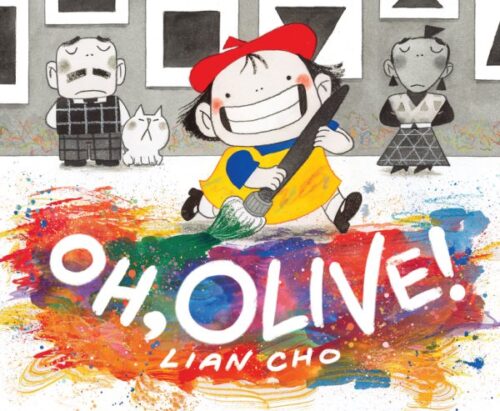
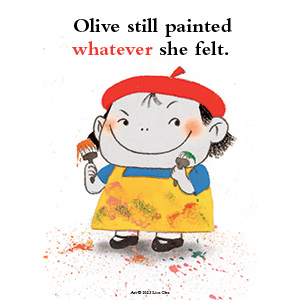
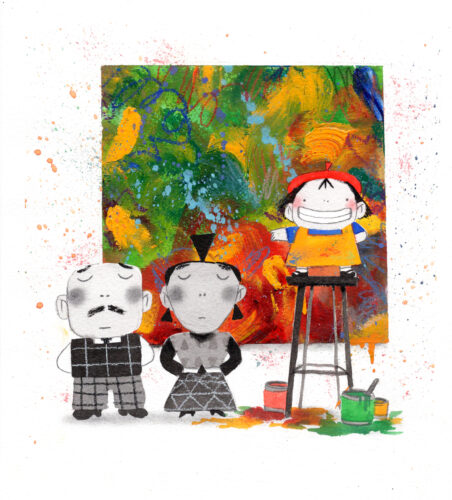
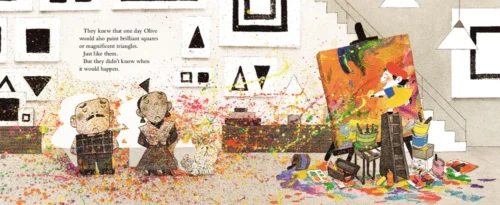
Olive Chen’s parents are artists. They make serious squares and triangles. Olive doesn’t make shapes, she makes colors! Does that mean Olive is an artist too? I encountered this and figured I’d just be able to write it off. BIG mistake. This is a complete and utter delight. I had liked Cho’s art for Adam Rex’s Oh No, the Aunts Are Here (if we shelved picture books by title they’d be right next to one another on the shelf!) but clearly this is her passion project. I was completely delighted by Olive herself, and her manic energy. Cho’s art is legitimately beautiful to look at, hella colorful, and so much fun. We’ve seen this kind of story done before (Big Orange Splot comes to mind) but rarely so delightfully. It also sticks the landing, which is no small thing. Kinda adore this one.
Papá’s Magical Water-Jug Clock by Jesús Trejo, ill. Eliza Kinkz
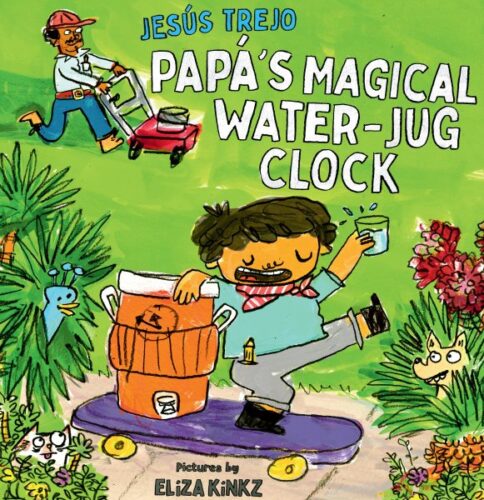
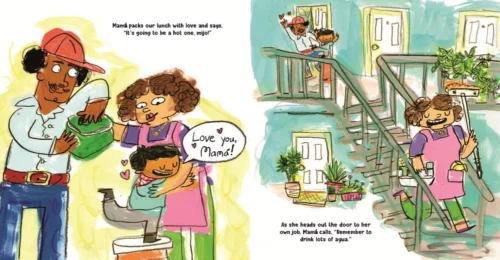
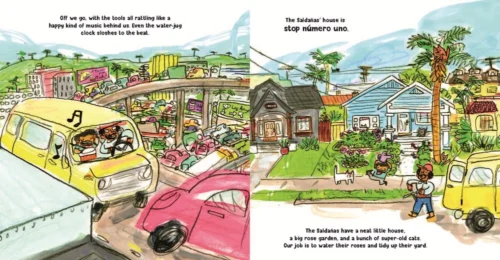
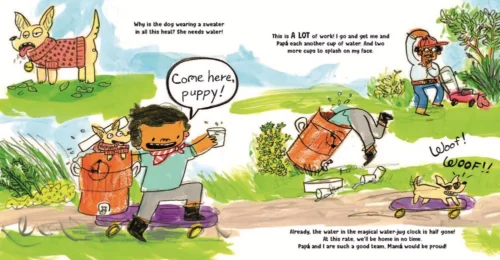
It’s Saturday so Jesús gets to go with Papá on his landscaping jobs. Papá says when their water-jug is empty it’s time to go home. So what’s so wrong about giving the jug a little help? Hilarity (and copious water consumption) ensues. I just love this one. Eliza Kinkz is rapidly becoming one of my favorite new illustrators. Last year we saw a nice, touching story from John Parra called Growing an Artist that talked about his dad as a landscaper. This book is in the same subject area but takes this fun, wild, goofy attitude. It also is a great example of kid-logic. I mean, if you tell a kid that when the jug is empty you get to go home, the kid is going to do whatever they can to speed that process along. The readaloud potential is fantastic (particularly the moment when the kid has a breakdown). Kinkz, meanwhile, may illustrate the best elderly cats I’ve seen in a book in years. Funny and kind of touching and contains a great scream of frustration as well. And is it available in Spanish? It IS available in Spanish! Previously Seen On: The Readaloud List
The Real Story by Sergio Ruzzier
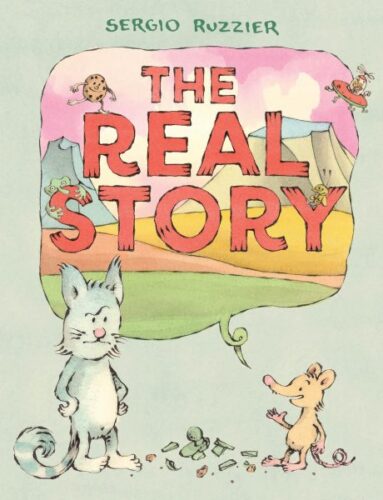
Cat comes in to find the cookie jar smashed and the cookies gone. What’s the real story behind the crime? As Mouse weaves improbable tale after improbable tale, the truth will have to come out. This book, I will be honest, made me laugh out loud more than once. It has magnificent readaloud potential (who doesn’t like reading cranky characters?) and I loved the offhand lines like “Honestly we should be happy for them”. Additionally (and this is key) the book is on the younger side with a simple text. We are often so desperate for books of this sort that it’s a vast relief when we find them. An easy, lovely, wonderful little title.
The Red Tin Box by Matthew Burgess, ill. Evan Turk
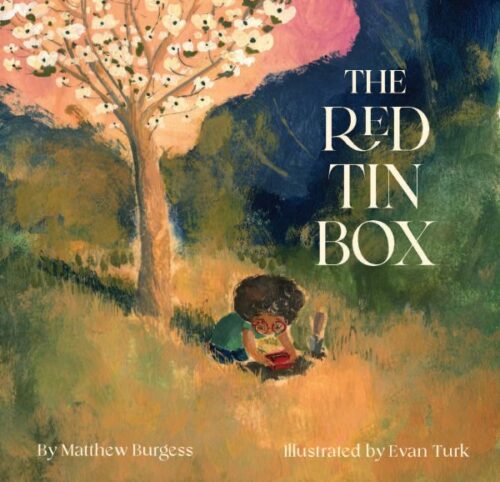
When Maude turns eight, she buries a secret in a red tin box beneath a flowering dogwood. When Maude is a grandmother, she goes back. A beautiful story of generations and hidden treasures. Do you ever play that game where you pretend to be a picture book editor and then you play around with what would happen if you paired up some of your favorite authors with your favorite illustrators? Just me? Cool. Cool. Well, that’s my roundabout way of saying that this Burgess/Turk combo would totally be one of my ideal pairings. Turk is sometimes wholly reliant on the strength of a book’s text, and fortunately this story is a great match for his talents. I love how much of the second half shows that late afternoon setting sun light you only get in the autumn. Just between you and me, when I was a kid I buried a box of “treasures” in the ivy next to my parents’ house. Unlike Maude, I’ve no idea where exactly I put it. A book that not only inspires kids to think about the future, it may also give them the ability to realize that their parents and grandparents were once children like them too.
The Search for the Giant Arctic Jellyfish by Chloe Savage
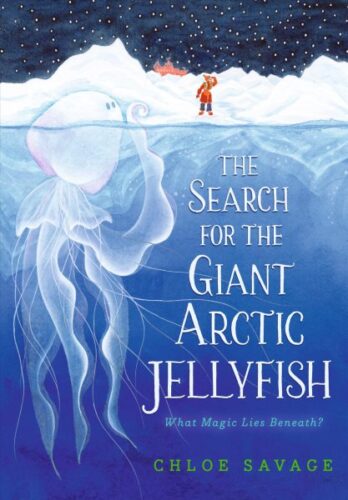
Dr. Morley and her superb crew are embarking on an adventure to finally see a giant arctic jellyfish. Will they succeed or is the jellyfish more elusive than they think? The best description of this book that I can come up with is probably something along the lines of Where’s Waldo meets The Life Aquatic with Steve Zissou. I loved the tiny details and characters’ relationships to one another (which two are the ones getting engaged under the Northern Lights?). I’m also quite fond of the matter-of-fact statement that a woman scientist is leading this expedition. It reads aloud brilliantly (you really have to punch the words “giant. arctic. jellyfish,” when they come up) and, of course, the jellyfish itself is just so sweet. And those colors! It’s a kooky little thing, but I’m awfully fond of it. You know who else is fond of it? Actual scientists! My library has an award (The Blueberry) that we give out for Nature and Environmental books for kids, and we always make sure to have a couple naturalists, scientists, and experts to round out the committee. What book do they overwhelmingly love this year? This one, baby. Previously Seen On: The Informational Fiction List
Soon, Your Hands by Jonathan Sturzman, ill. Elizabeth Lilly
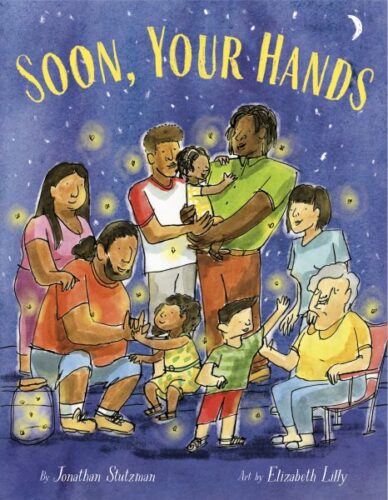
“Tonight, your hand fits inside my own. But soon your hand will grow…” Three families with small children advise and guide until their children become adults themselves. A touching, lovely paean to kids becoming their true selves. Maybe I’m just getting to be an old softie in my old age, but after sitting on this book for a little while it really stuck with me. A lot of that has to do with Elizabeth Lilly’s art, which is just so freakin’ charming. But this really comes across as one of the best examples of how you can do books centering different voices and experiences and make a truly fantastic story out of those people. And yes, that ending kind of hit me in the tear ducts. Like I said. I’m an old softie now.
Stickler Loves the World by Lane Smith
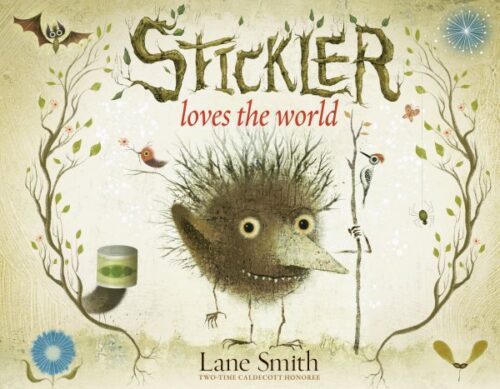
What’s better than loving the world? Getting to show it to someone else for the first time! A thorny little hero gets to show an “alien” why our planet is so darned great. Lane Smith is never boring, but recently he’s avoided the rampant wackiness of his earlier books in favor of heartfelt, meaningful, Henkes-esque stories. Nothing wrong with that. A man’s allowed to mellow with age. Still, it does sometimes leave one yearning for his early days and penchant for wildness. Maybe that’s why I love his latest so very very much. It’s this utterly marvelous combination of the visual wildness of his youth and his more contemporary yearning to celebrate the natural world and all its glory. Stickler looks a little scary, standing there with his stick-like hair and sharp, pointy teeth, but he genuinely loves life and living and our world. He’s got Gappers of Frip energy and a heart of gold. And because Lane combines these visuals with this text, what could have come off as cutesy is instead honestly and legitimately meaningful. You just want to kiss a stick after reading this. My favorite Lane Smith book in years and years. Previously Seen On: The Message List
Stinkbird Has a Secret by Jill Esbaum, ill. Bob Shea
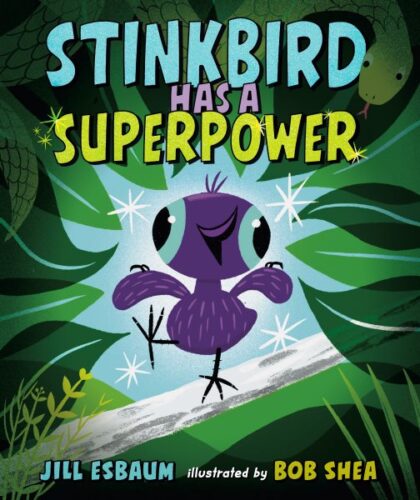
Every time I see an artist that normally works in the realm of fiction switch it up and do a little nonfiction, my heart sings. It sang last year when Steve Light illustrated Larissa Theule’s Concrete: From the Ground Up and it’s singing like a stinky little bird thanks to Bob Shea illustrating Jill Esbaum’s Stinkbird Has a Secret. I’m just gonna say it: This may be my favorite kind of book. It’s a title that tells a range of bizarre facts about an animal, ending with the strangest of them all. And no, if you’re assuming that the final fact about the hoatzin is that it stinks like poop, you could not be more wrong. That’s literally the first weird fact they mention. After that, it manages to come up with an even wider range of weirdnesses, from the fact that they build their nests precariously over rushing rivers, to a baby hoatzin’s ability to swim. But I ain’t giving away that final fact. No, sir. Bob Shea pulls out all his most expressive technicolor talents here, making him the perfect person to bring this tale to life. Thanks to the talking birds and plot, you can’t quite call this straight nonfiction, so I’m calling this a perfect example of informational fiction instead. A smelly old delight. Previously Seen On: The Informational Fiction List
Summer Is For Cousins by Rajani LaRocca, ill. Abhi Alwar
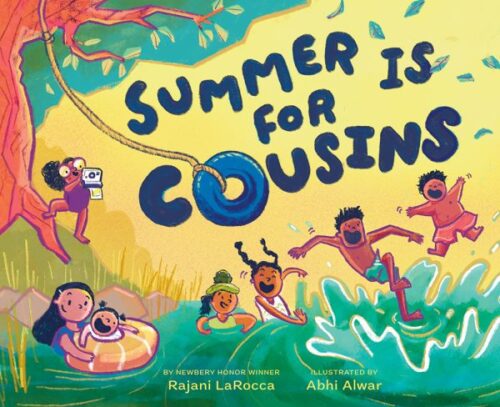
Seven cousins and their extended family members spend time at the lake house. Ravi adores his older cousin Dhruv, but will the older boy remember the special dessert that bonds them together? Maybe it’s because I was always the younger cousin, so shy around my older ones, but I really related to this title. Rajani is particularly good at getting the feel of something in a short span on the picture book page. Ravi is just so identifiable. Kids with lots of cousins will identify with this while kids that don’t will yearn for some of their own. And whoever thought to tap Abhi Alwar for the art is some kind of a genius. The pictures fit the tone to a tee.
10 Cats by Emily Gravett
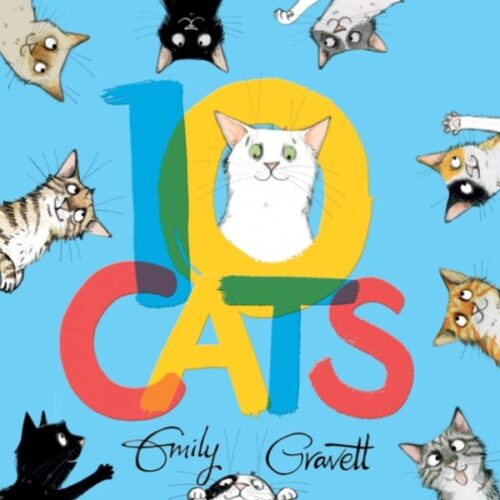
Nine kittens and mama cat get into a mess of feline trouble with colorful results. This is just your average counting/color mixing/pattern recognition/seek-and-find book filled to the brim with adorable kits. Now 2023 was a pretty heavy year in terms of serious, meaningful content. But when making my lists, I need to balance some of that sobriety out with lighter and younger fare. Enter, Emily Gravett. I like cats but I don’t just fawn over every cat picture book I see. This one, however, is exceedingly simple but is doing several things at once. It’s a counting book, a seek-and-find, and a color mixing title all at once. There’s also a bit of pattern recognition (which math aficionados love to see in picture books). I think I can honestly say it’s one of the better counting books I’ve seen in a long time. Simple but doing a bunch of different things at once and doing them exceedingly well. Making a book like this is harder than it looks! Previously Seen On: The Math List
Ten-Word Tiny Tales to Inspire and Unsettle by Joseph Coelho and 21 Artist Friends
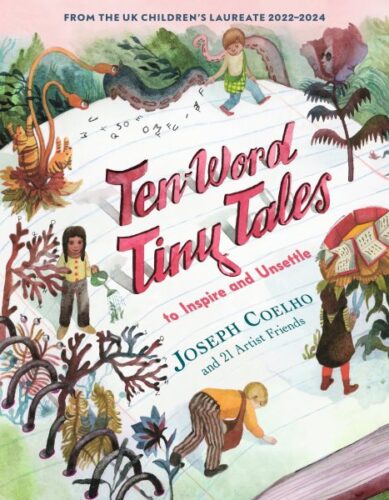
Tell me a story in just ten words. One poet tells 21 tales and 21 artists give their interpretations. Part writing prompts, part short stories, and all very very interesting. Oh ho! This one’s great! Sort of what you’d get if you asked a bunch of authors to do a visual riff in the vein of The Mysteries of Harris Burdick. Joseph Coelho isn’t afraid to get creepy, which I appreciate thoroughly, and he also not shy in saying outright that this is a book of writing prompts. Personally, I think that a number of these artists could have been significantly creepier with their interpretations. Fortunately, you have folks like Thea Lu, Júlia Sardà (so good!), and Karl James Montford to make up for it. The book is worth it for the Shaun Tan image alone: “Every year they honored their son by decorating his skull.” I’d get that one as a poster if I could. A perfect accompaniment to Halloween too! Previously Seen On: The Unconventional List
That Flag by Tameka Fryer Brown, ill. Nikkolas Smith
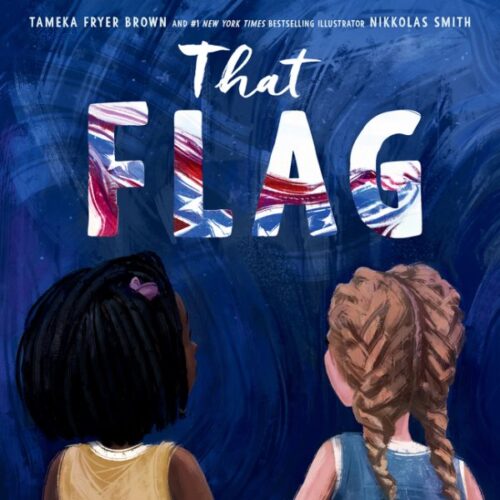
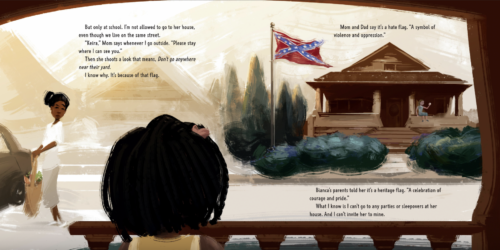
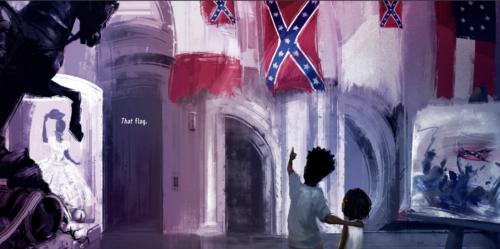
Keira’s Black and Bianca’s White and they are definitely best friends. But why won’t Keira’s family let her play across the street? And does it have anything to do with the flag in Bianca’s yard? Tameka Fryer Brown steps out of her comfort zone and into a highly politicized, and necessary, conversation for kids. I’m trying to think of other picture books where the heroine loses not just her innocence but also her best friend in a span of pages this brief. What’s so important about this story is how Brown centers Keira’s story. This isn’t about Bianca, the white friend, and her awakening (though it seems to happen off-stage to a certain extent). Keira’s feelings are the ones being centered here. It is interesting reading this as an adult too, and understanding what Keira’s parents are going through, even when she can’t see it (especially when she can’t see it). Nikkolas Smith is the same fellow you saw illustrating the 1619 Project: Born on the Water and I Am Ruby Bridges. He’s rapidly becoming one of my favorite illustrators, and what he doesn’t show here is as important as what he does. This is distinctly tricky subject matter handled with aplomb.
This is Not My Home by Eugenia Yoh and Vivienne Chang
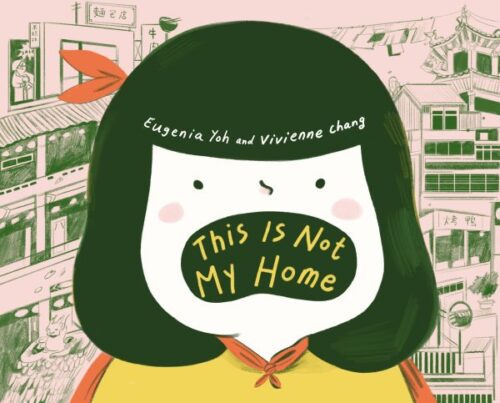
When Lily’s mom suddenly tells her one day that the two of them are moving to Taiwan it does NOT go well. An honest (and honestly funny) take on how hard it is to let go of everything you know and start anew. When I was in Bologna I heard all these people over there saying how Americans like happy endings in their children’s books too much. The implication being that we can’t handle complexity. So maybe that was in my mind when I read this, but I just really got a huge kick out of what Yoh and Chang are putting down here. They’re not sugarcoating this move at all. This girl is leaving behind literally her entire life and she is NOT happy about it (absolutely adore the “Lily was not understanding” sequence where her mouth is a perfect upside down U the whole time). There’s a lot of honest emotions in this book and a fair bit of humor, but what really knocked it out of the park for me was how the creators of the book showed how much time it took before Lily was able to say that Taiwan is now her home. It’s not this overnight revelation or anything. Well made.
The Three Little Mittens by Linda Bailey, ill. Natalia Shaloshvili
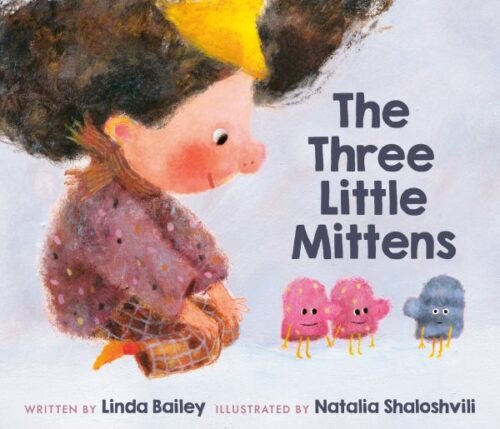
As someone who spent the better part of the age of four marrying off my crayons, I’ve a particular affection for stories about inanimate objects with Feelings (with a capital F). I also am very fond of books where the author takes a universal kid experience and puts a brilliant little spin on it. Like losing mittens, for example. I know that with my own kids the process of keeping track of mittens is, at times, a Sisyphian task. In this story, one little striped mitten is the odd one out. Doomed to stay in a girl’s pocket while the matching pair get to pat dogs and do other fun things, everything changes the day one of the pair gets lost and the striped mitten’s double is found. But why precisely do we have to always wear matching mittens, questions the girl. For a young child, asking this question is like questioning a greater authority. Nonetheless, the floodgates open and that cardboard box holding all the mismatched mittens and gloves (you know the one) releases and suddenly everyone gets a chance to be used again. But why stop there? Socks get into the act. Then shoes! “And after that? Well, as you can see, life was never going to be the same again!” I’m a big fan of the subtly subversive in picture books (hey, you gotta start somewhere) and this book fits the bill. Plus I am VERY charmed by this Natalia Shaloshvili. This is her first book in English, and I certainly hope that we get to see a lot lot more of her in the future. Like they say, if the shoe fits . . .
To the Other Side by Erika Meza
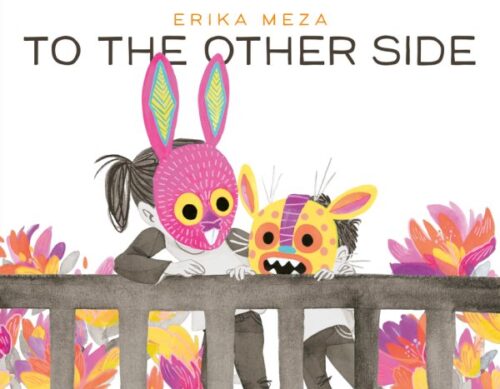
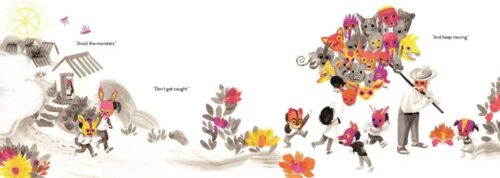
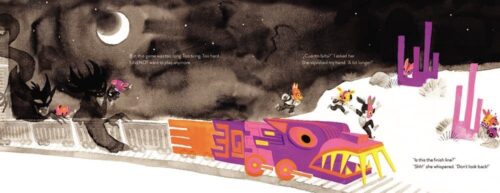
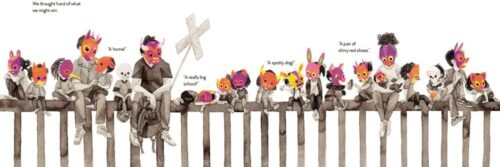
“The rules of the game are simple.” A boy and a girl leave home playing a game, making their way towards a border where they hope to change their lives. A beautifully rendered look at child refugees traveling on their own. I’m about to have words with Harper Collins. I get how their whole we-don’t-want-to-do-physical-galleys justification works, but we are missing some seriously good books these days thanks to that policy. Last year I completely missed Mariana and Her Familia by Mónica Mancillas, illustrated by Erika Meza and I’m still mad about that. Of course what it ended up doing is putting Meza on my radar, so when I heard she had another book out this year I wanted it immediately. This is rough subject matter handled with a deft hand. It’s entirely about young refugee children traveling on their own, but done with flair, color, and cleverness. I just keep looking at that final shot of the boy having completely abandoned his mask while his sister sits next to him, still holding her own, unable to let go.
The Tree and the River by Aaron Becker
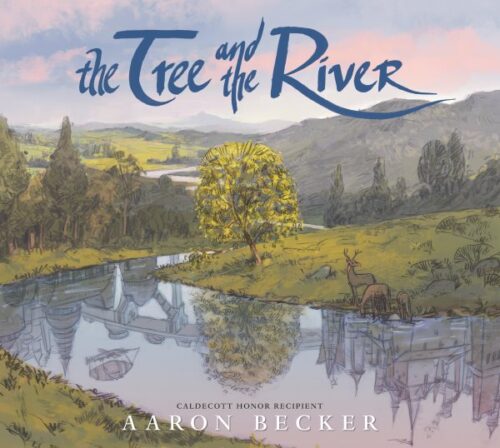

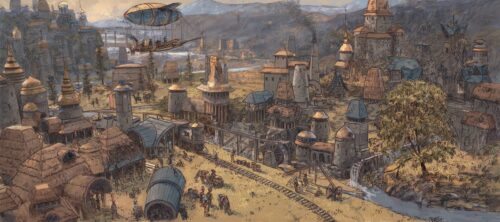

Boy, what is it about science fiction and wordless picture books, eh? A single tree sits on the small peninsula as civilizations rise and fall around it. A beautiful detail-rich wordless story of human hubris and hope. Oh yes! Becker’s back! Some of you may recall his Journey series from a couple years ago. It was an epic three-part wordless fantasy series in picture book form. Then Becker made A Stone for Sascha which felt more like a prelude to this book than anything else. Now he’s returned with another epic wordless story, and this one feels like more like a Mitsumasa Anno boo, of which I thoroughly approve! There is just so much for kids to pick apart in this wordless storyline. Who won the war? How have the two cultures seen in the book integrated? How is this a book about what might happen to us in the future? In spite of the fact that the world clearly floods due to a global warming of some sort, the book ends on a pretty hopeful note. No small task for something completely wordless. One of the most accomplished picture books of the year. Also, because I am just that petty, I would like to point out that my review called out that Planet of the Apes moment at the beginning of the book long before anyone else’s. *grabs all her toys and runs away* Previously Seen On: The Science Fiction List
A Walk in the Woods by Nikki Grimes, ill.. Jerry Pinkney and Brian Pinkney
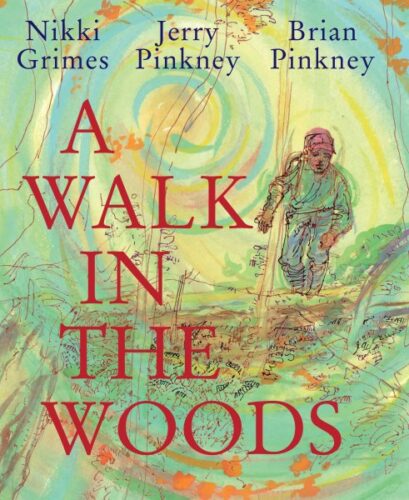
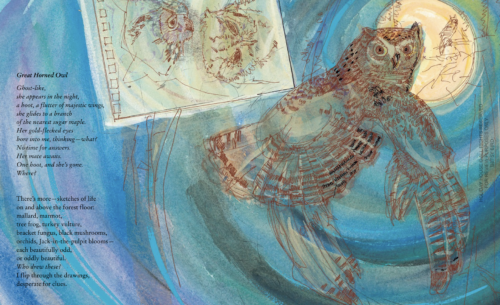
After his father dies, a boy takes a walk in the woods with the treasure map his dad left him. A powerful testament to love, family, and nature. We’ve two posthumous Jerry Pinkney titles out this year, but to my mind A WALK IN THE WOODS is the most touching, effective, and successful. Even if you read this book without knowing that it was a collaboration between a deceased father and his son and granddaughter, you’d be moved and amazed by the writing and art. There’s the element of nature healing grief, and just the beautiful poetry by Nikki Grimes that appears like a special treat a little more than midway through. This works on every level as a book and makes for a marvelous testament to Jerry’s skills and life.
Water Day by Margarita Engle, ill. Olivia Sua
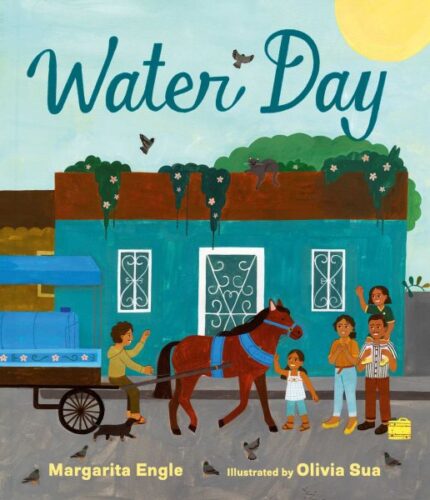
It’s water day! Today the water man will come and bring refreshment for yet another week. A trip to Cuba and a serious story about the water we need. A lot of times when I read a book like this, I struggle with what would be interesting to kids vs. what’s interesting to me, the adult gatekeeper. For instance, the fact that there’s a fish lady who puts fish into water tanks to eat mosquito larvae? That alone struck me as amazing! But I think the reason that this book works as a whole is that it has a really approachable, interesting day-in-the-life aspect to it. Neat!
Zora, the Story Keeper by Ebony Joy Wilkins, ill. Dare Coulter
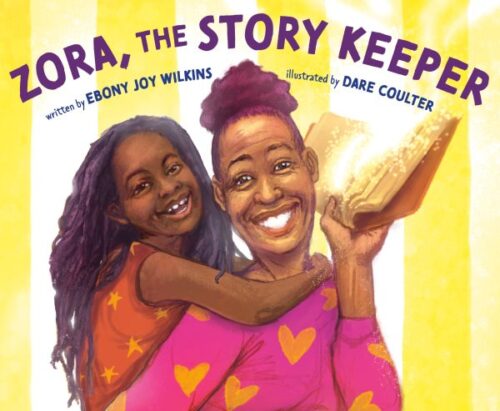
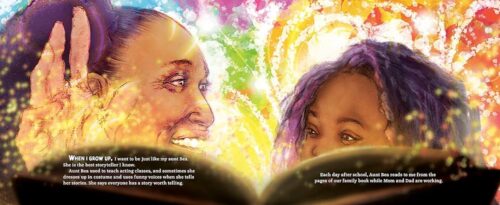
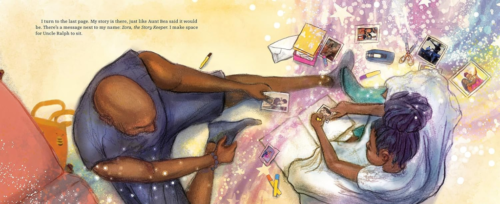
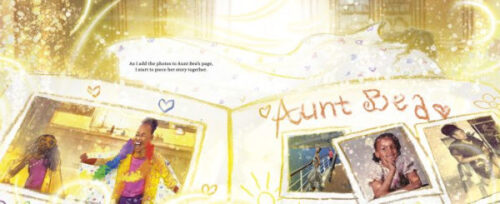
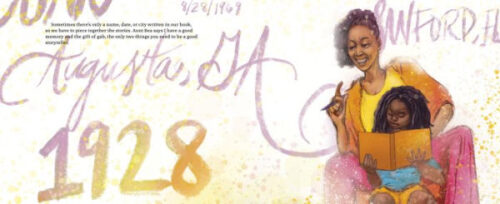
Whenever Zora hangs out with her Aunt Bea she hears the amazing stories of her family and ancestors. But as Aunt Bea starts to get sick, who will be the next story keeper? This one really grew on me. There’s something about the writing that just struck me as a little different from the other books out there. A depth to it. A deeper meaning. Plus, the aunt in this book just felt so frickin’ real. There are levels to this, where you can read it as a kid on the one hand and as an adult on the other. Dare Coulter, of course, already did the art for that new Kwame Alexander title. Worth a read, at the very least.
Hope you enjoyed these! Here are the lists you read this month:
December 1 – Great Board Books
December 2 – Picture Book Readaloud
December 3 – Simple Picture Book Texts
December 4 – Transcendent Holiday Picture Books
December 5 – Rhyming Picture Books
December 6 – Funny Picture Books
December 7 – CaldeNotts
December 8 – Picture Book Reprints
December 9 – Math Books for Kids
December 10 – Gross Books
December 11 – Books with a Message
December 12 – Fabulous Photography
December 13 – Translated Picture Books
December 14 – Fairy Tales / Folktales / Religious Tales
December 15 – Wordless Picture Books
December 16 – Poetry Books
December 17 – Unconventional Children’s Books
December 18 – Easy Books & Early Chapter Books
December 19 – Older Funny Books
December 20 – Science Fiction Books
December 21 – Fantasy Books
December 22 – Comics & Graphic Novels
December 23 – Informational Fiction
December 24 – American History
December 25 – Science & Nature Books
December 26 – Unique Biographies
December 27 – Nonfiction Picture Books
December 28 – Nonfiction Books for Older Readers
December 29 – Audiobooks for Kids
December 30 – Middle Grade Novels
December 31 – Picture Books
Filed under: 31 Days 31 Lists, Best Books, Best Books of 2023
About Betsy Bird
Betsy Bird is currently the Collection Development Manager of the Evanston Public Library system and a former Materials Specialist for New York Public Library. She has served on Newbery, written for Horn Book, and has done other lovely little things that she'd love to tell you about but that she's sure you'd find more interesting to hear of in person. Her opinions are her own and do not reflect those of EPL, SLJ, or any of the other acronyms you might be able to name. Follow her on Twitter: @fuseeight.
ADVERTISEMENT
ADVERTISEMENT
SLJ Blog Network
Name That LEGO Book Cover! (#53)
Exclusive: Vol. 2 of The Weirn Books Is Coming in October | News
Fighting Public School Book Bans with the Civil Rights Act
Take Five: Middle Grade Anthologies and Short Story Collections
ADVERTISEMENT








When I taught third grade I had a tradition of stopping by my fellow staff members rooms on the first day of school and saying to them, “Think of it this way, we are now one day closer to next year’s summer vacation.” And so today I say “we are just eleven months away from December 2024 when hopefully we will meet again and do all of this once more.” In the meantime hopefully there will continue to be reviews of new books, old books, and children’s literature related topics to devour several times each week.
THANK YOU, Betsy, for all you do to support my passion for children’s books and their creators. I appreciate every word you write about them, the opportunity to comment, and also the time you often take to respond to my comments and questions.
Thank you so much, Betsy, for sharing these lists of such wonderful books. I would have missed most of these if it weren’t for you. I look forward to your 31 Days 31 Lists each year. I always have my local public website open and my “to order” list open as I read each day’s list carefully. I appreciate you sharing your expertise and your time with us!!!
What a great list to end the month. I read lots of picture books, but see so many “new” titles I missed over the year. Can’t wait to enjoy sitting with the stories and illustrations. And yes- the concrete garden blew me away!